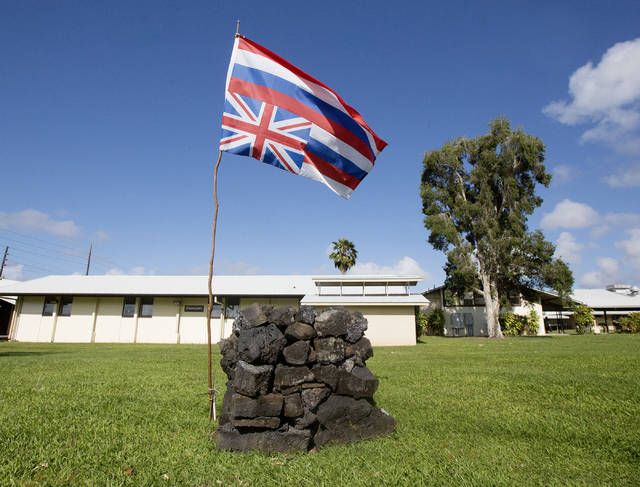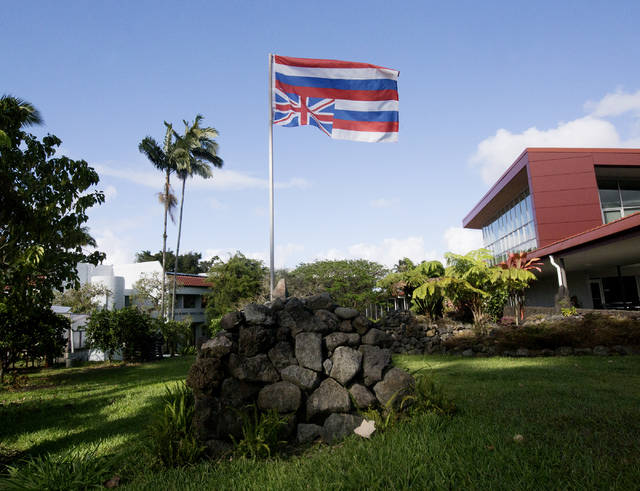Hilo colleges are taking different approaches to two on-campus ahu — or stone altars — which a student group claims it constructed to bring attention to “124 years of genocide continuing on the Hawaiian community.”
Kalaniakea Wilson, a University of Hawaii at Manoa doctorate student, told the Tribune-Herald he is a leader of a statewide group of students called Ahahui Hae Hawaii, or the Hawaiian Flag Society.
He said the group — comprised of Hawaiian and non-Hawaiian students — is responsible for erecting an ahu at least two years ago at the University of Hawaii at Hilo. The ahu, located near the Campus Center, was built in response to student arrests on Mauna Kea, he said.
In late 2015, Wilson said group members constructed a similar ahu located near the front entrance of Hawaii Community College.
Each ahu at the Hilo campuses feature an upside-down Hawaiian flag, which Wilson said is an “internationally recognized symbol” of a nation in distress.
He said students also constructed inverted-flag ahu at UH-Manoa and Kauai Community College. He said the group ultimately wants to bring attention to “illegal acts of war from Jan. 16, 1893, by the U.S. government.”
“That’s the student message,” Wilson said. “We need this resolved; 124 years is too long.”
But the ahu haven’t come without some controversy. Last school year, a UH-Hilo student anonymously contacted the Tribune-Herald and said he felt threatened by the UH-Hilo ahu structure’s statement — specifically the inverted flag — and questioned why it was allowed to remain on campus permanently.
HCC also has received “whistle-blower complaints” about its ahu, Chancellor Rachel Solemsaas told the Tribune-Herald recently, which have come from students, faculty, community members and “veterans who feel disrespected.”
Administrators at both campuses say they’ve engaged “extensively” with several of the students who claim responsibility and are now following guidance from their campus Native Hawaiian councils.
UH-Hilo said it has largely left the structure — flag and ahu — in place.
Campus administrators say they are treating the flag and ahu as a “single installation,” as they believe both were constructed at the same time. The campus has “never removed the flag on the ahu and (has) no plans to do so,” Gail Makuakane-Lundin, UH-Hilo interim executive assistant to the chancellor, told the Tribune-Herald in a message.
HCC, meanwhile, has treated the flag and ahu separately. The campus consulted with its Native Hawaiian council, which determined removing the flag — considered a “form of free speech” — would not be disrespectful of Hawaiian culture, spokesman Thatcher Moats said in an email.
HCC officials believe the flag was added after the ahu was constructed. The ahu is considered separate as a “symbolic structure,” Moats said.
Since April, HCC has removed more than a dozen flags from the ahu, each time notifying the student group “where (the flag) is, and that they are free to pick it up,” Solemsaas said.
HCC is now developing a campus policy to better address the issue. The goal is to protect free speech rights while establishing an appropriate “time, place and manner” to display exhibits in the future, Solemsaas said.
“Our position is not to take sides, I want to make that clear,” Solemsaas said.
“Our position is to make sure we provide a civil and respectful venue where people can practice their constitutional rights of free speech (while adhering) to our mission as a learning environment and not (negatively) impacting student learning.”
The student group isn’t quite on board, however. Wilson said the group views each flag removal as a “federal violation.”
He said about 25 flags have been removed from ahu at UH campuses around the state, and he believes some ahu have also been “vandalized.” For example, he previously sent the Tribune-Herald a photo that appeared to show an American flag stuck in the HCC ahu. He said that photo was taken at the beginning of the 2016-17 school year.
UH’s free expression policy states that on-campus, free speech activities cannot “interfere with or disrupt the education process or
other scheduled activities.”
The policy gives campus chancellors discretion to designate one or more on-campus “forum areas” for “public speech activities.”
Campus chancellors also have authority to develop “campus specific guidelines” designating “time, place and manner for free speech and other constitutionally guaranteed expressive activities.”
The policy encourages chancellors to seek input from campus organizations and staff when developing those free speech guidelines.
Email Kirsten Johnson at kjohnson@hawaiitribune-herald.com.









